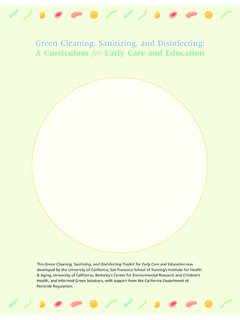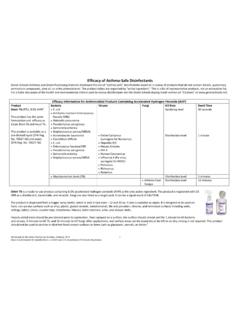Transcription of Tips for Cleaning Child Care Facilities the Safe & Healthy Way
1 Tips for Cleaning Child Care Facilities the Safe & Healthy Way Know the Difference between Cleaning , sanitizing & disinfecting Cleaners: All purpose cleaners ( green cleaners/soap/detergent & water) remove dirt and most organisms. Sanitizers: Sanitizers reduce bacteria to safe levels on inanimate surfaces. They are registered by the EPA. Disinfectants: Disinfectants destroy multiple organisms including bacteria and many viruses on non-porous surfaces. Disinfectants are pesticides regulated by the EPA. Select disinfectants carefully: Know what organism(s) it is effective against. Use correctly. READ THE LABEL. Clean surfaces before use. Use appropriately only in target areas. Know when to sanitize and when to disinfect. As a general rule, disinfect only areas/objects that come in contact with bodily fluids; sanitize area/objects that are touched by many hands and food areas/items.
2 Children are at greater risk for exposure to toxic chemicals: Their body systems are still developing; exposure to chemicals can have a greater health impact. They eat, drink and breathe more in proportion to their size. Their behavior- crawling on floors, putting things in their mouths- can expose them to more chemicals and organisms. Therefore, it is important to avoid introducing unneeded chemicals into the Child care environment. Recommended Cleaning Protocols for Child Care Areas Area Clean w/ green Cleaner Sanitize Disinfect General: shelves, windows, high countertops, carpets, glass X Surfaces touched by many hands (doorknobs, push bars, stair railings) X X Diaper changing areas, bathrooms X X Mouthed toys; water fountains X X Kitchen: eating utensils, bottles, dishes; food preparation areas (where food is served, stored or prepared) X X Surfaces/Objects contaminated w/blood & body fluids X X During an outbreak of GI illness or flu, clean/sanitize more frequently, between uses or groups.
3 Using Bleach Safely & Effectively If you choose to use bleach to sanitize or disinfect, follow these precautions: Use prudently and appropriately (only on surfaces that need to be disinfected, bathrooms, and where there is blood, vomit, feces or sanitized, high touch points). Treat as toxic; use in well-ventilated areas and away from children; use gloves. Make dilution daily; open a new bottle of bleach every month as it loses its effectiveness; use the appropriate dilution for sanitizing and for disinfecting (stronger). Follow the manufacturer s directions. The dilutions may be different depending on the brand and concentration. Note: There is a new concentrated ( ) bleach on the market. Label the container with the name of the product, health hazard information, use and date prepared. Clean with a general-purpose cleaner/soap & water BEFORE bleach is applied. Leave on surface for 2 minutes and allow to air dry.
4 If area/item is going to be used right away, rinse. Alternatives to Bleach. There are EPA registered sanitizers that use hydrogen-peroxide or other safer chemicals as the main ingredient. Talk with your supplier to find a product. Reminder: sanitizing food contact surfaces requires an EPA registered sanitizer that is approved for food contact surfaces. Follow the manufacturer s instructions. green Cleaning green Cleaning products are products designed to have less effect on human health and the environment when compared with competing products that serve the same purpose. green Cleaners are certified by a third party such as green Seal, Eco-Logo or Design for the Environment (DfE). Use green cleaners to clean before sanitizing or disinfecting and on surfaces that do not need to be sanitized or disinfected. READ THE LABEL on ALL Products Look for Signal Words: Poison (most dangerous), Danger, Warning, Caution (least dangerous).
5 Check the ingredients: Look for products with less toxic ingredients such as plant-based ingredients, no ammonia, no bleach, no fragrance, and with a more neutral pH (7). Look for the EPA Registration number on sanitizers and disinfectants. Look for products that are certified by an independent third party: green Seal, Eco-Logo, Design for the Environment. For more information: Third Party Certifiers: green Seal , Eco-Logo or Design for the Environment (DfE) Minnesota: Infectious Diseases in Childcare Settings and Schools Manual Caring for Our Children: National Health and Safety Performance Standards Cleaning for Healthy Schools - Infection Control Handbook green Cleaning , sanitizing , and disinfecting : A Curriculum for Early Care and Education 2/ 2011; 1/2012 rev; 7/2013 rev











